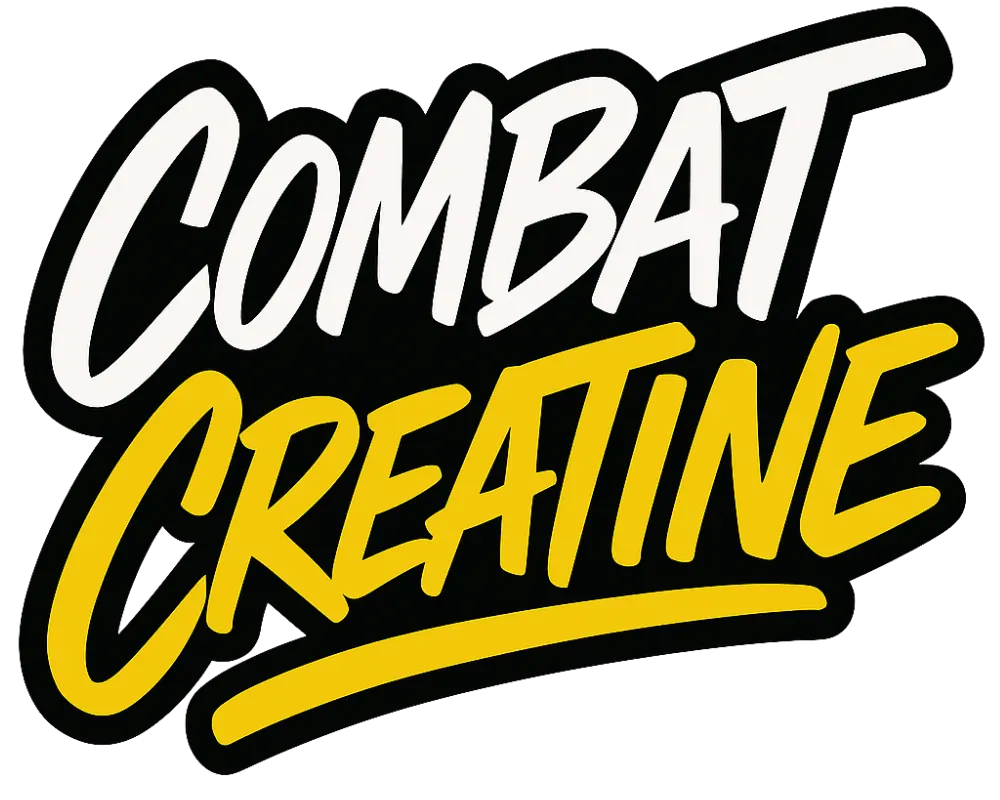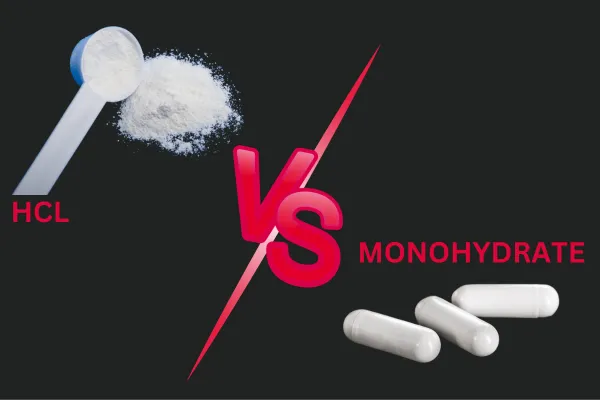Shoulder Impingement Exercises For Shoulder Impingement Syndrome
Unlock Relief: Top Shoulder Impingement Exercises for Pain-Free Movement
Have you ever lifted your arm and felt a sharp pain in your shoulder? That could be a sign of shoulder impingement syndrome, a common condition that affects the shoulder joint.
This article dives into the world of shoulder impingement exercises, offering you a lifeline to reduce pain and improve mobility. With exercises crafted to target the specific areas of concern, this read is not just informative but a practical guide to reclaiming your comfort and range of motion.
Let's explore how these exercises can transform your daily activities into pain-free movements.
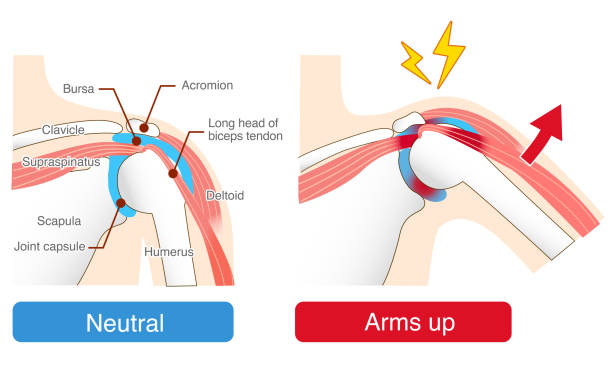
What Is Shoulder Impingement Syndrome?
Shoulder impingement syndrome occurs when the tendons of the rotator cuff muscles become irritated and inflamed as they pass through the subacromial space, leading to pain and restricted movement.
This condition is particularly common among individuals engaging in repetitive overhead motions or those with poor posture.
Understanding this syndrome is the first step towards effective management.

Why Are Shoulder Impingement Exercises Essential?
Exercises for shoulder impingement are crucial because they strengthen the rotator cuff muscles, improve flexibility, and enhance the shoulder joint's stability.
These exercises not only alleviate pain but also prevent future occurrences by correcting the underlying issues contributing to impingement.
How Can You Test for Shoulder Impingement?
A physical therapist or healthcare provider can perform specific tests to diagnose shoulder impingement.
However, recognizing early symptoms, such as pain during overhead activities or difficulty reaching behind your back, can prompt you to seek treatment sooner.
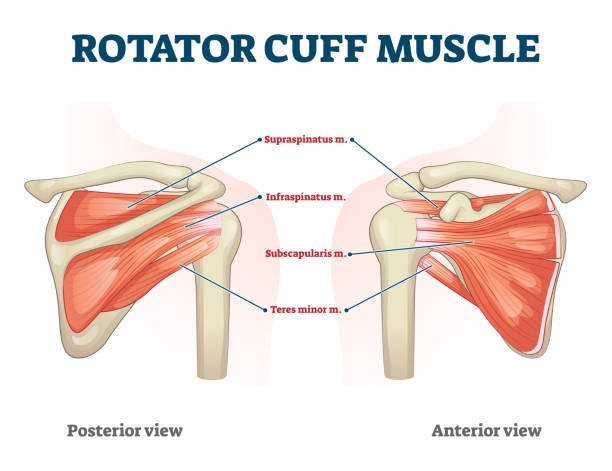
The Role of the Rotator Cuff in Shoulder Health
The rotator cuff is a group of muscles and tendons that surround the shoulder joint, providing stability and allowing a wide range of motion.
Strengthening these muscles is pivotal in managing shoulder impingement syndrome.
Starting Simple: The Doorway Stretch
Stand in a doorway with your arms on the door frame at a 90-degree angle, then gently lean forward.
This stretch opens up the shoulders and chest, promoting flexibility and reducing tension in the muscles and tendons affected by impingement.
The Power of Resistance Bands
Incorporating a resistance band can significantly enhance shoulder strengthening exercises.
For example, external rotations with a band work the rotator cuff muscles, vital for stabilizing the shoulder joint.
Engaging the Serratus Anterior
The serratus anterior plays a crucial role in shoulder movement and stability. Exercises like the wall slide are designed to strengthen this muscle, improving shoulder blade movement and reducing the risk of impingement.
Elevating Your Exercise Routine with Wall Push-Ups

Wall push-ups target the shoulder and pectoral muscles without putting excessive strain on the shoulder joint.
This exercise is ideal for gradually building strength in the early stages of recovery from shoulder impingement.
Finding Relief Through Stretching: The Cross-Body Reach

The cross-body reach stretch helps relieve tension in the shoulder by stretching the muscles and tendons that can contribute to impingement. It's a simple yet effective way to increase flexibility and reduce pain.
Diving Deeper: External Rotation at 90 Degrees
This exercise is a step up, requiring you to keep your elbow bent at a 90-degree angle while rotating your arm outward. It's excellent for targeting the rotator cuff muscles in a position that promotes healing and strength.
The Significance of Elbow Positioning
Keeping your elbow close to your body during exercises can help minimize stress on the shoulder joint. This technique is particularly important in exercises aimed at strengthening the rotator cuff and reducing impingement symptoms.
Incorporating Full Body Movements: The Scapular Wall Slide
The scapular wall slide is a comprehensive exercise that engages the shoulder blade (scapula) muscles, crucial for shoulder mobility and stability. This exercise helps align the shoulder blades, reducing the risk of impingement.
Understanding the Impact of Shoulder Blade Position
The position of the shoulder blade affects the overall function of the shoulder joint. Exercises that focus on proper scapular alignment can prevent the shoulder blade from contributing to impingement.
The Role of Daily Activities in Shoulder Health
Daily activities and posture significantly impact shoulder health. Incorporating exercises that mimic daily movements can help ensure the shoulder moves correctly throughout the day, reducing the risk of impingement.
Seeking Professional Guidance: When to Consult a Physical Therapist
While these exercises can be effective, consulting with a physical therapist ensures you're performing them correctly and safely, especially if your symptoms persist or worsen.
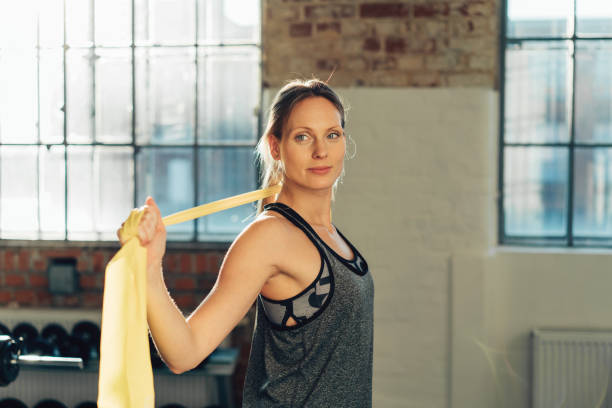
Key Takeaways for Managing Shoulder Impingement
- Prioritize proper technique to ensure exercises are effective and safe.
- Incorporate a variety of exercises to target different muscles around the shoulder joint.
- Be consistent with your exercise routine, as regular practice is crucial for recovery and prevention.
- Listen to your body and adjust the intensity of exercises to avoid overexertion.
- Consult a professional if you experience increased pain or have concerns about your exercises.
Managing shoulder impingement syndrome through exercises requires a delicate balance of strengthening, stretching, and stabilizing the shoulder joint.
By incorporating these targeted exercises into your routine, you can alleviate pain, improve mobility, and prevent future episodes of impingement. Remember, the key to recovery is not just in performing the exercises but in doing them correctly and consistently.
As you embark on this journey towards a healthier shoulder, keep in mind the power of perseverance and the importance of patience. Your shoulder didn't become impinged overnight, and it will take time and dedication to heal.

Maximizing Effectiveness: The Importance of Warm-Up
Before jumping into exercises, warming up is crucial. A gentle warm-up, such as arm circles or shoulder shrugs, prepares your muscles and tendons for the exercises ahead, reducing the risk of injury.
This practice not only enhances the effectiveness of your workout but also promotes blood flow to the shoulder area, aiding in recovery.
Enhancing Mobility: Pendulum Exercises
Pendulum exercises are a gentle way to start increasing shoulder mobility. Lean over, allowing one arm to hang down, and gently swing it in circles.
This movement helps decrease stiffness and promotes a range of motion in the shoulder joint, making it a perfect starting point for those experiencing significant discomfort.
Building Strength: Lateral Raises with a Twist

Incorporate lateral raises using light weights or a resistance band to strengthen the shoulder muscles.
Adding a slight twist at the end of the movement can engage the rotator cuff and deltoid muscles more effectively, providing a more comprehensive strengthening effect without overloading the shoulder.
The Role of Posture in Shoulder Health
Good posture is pivotal in managing and preventing shoulder impingement. Slouching can compress the shoulder joint and exacerbate symptoms. Exercises that reinforce good posture, such as thoracic spine stretches or scapular retraction exercises, can be invaluable.
These exercises not only support shoulder health but also contribute to overall spinal alignment.
Shoulder Impingement and the Role of Core Strength
A strong core supports the upper body, including the shoulders. Exercises like planks or bird-dogs that build core strength can indirectly benefit shoulder stability and reduce the strain on shoulder muscles, especially for those involved in overhead activities.
Incorporating Functional Movements
Exercises that mimic real-life activities are particularly beneficial. For instance, practicing reaching into overhead cabinets or behind the back mimics daily activities, helping your shoulder to adapt and strengthen in a functional context.
These movements encourage a full range of motion and ensure that strength gains are applicable to everyday life.
Advanced Strengthening: The Arnold Press
For those ready to advance their strengthening routine, the Arnold press is an excellent exercise. It combines a shoulder press with a rotation, targeting multiple shoulder muscles, including the rotator cuff.
Start with light weights and focus on form to prevent overexertion.
Understanding the Limitations
It's vital to recognize when to push and when to pause. If any exercise exacerbates shoulder pain, it's a signal to stop and reassess.
Pushing through pain can lead to further irritation or injury. It's always better to err on the side of caution and consult a healthcare professional if unsure.
The Benefit of Stretching: Shoulder Flexibility

Stretching plays a crucial role in maintaining shoulder flexibility and preventing tight muscles from contributing to impingement syndrome.
Stretches that target the pectoral muscles and the muscles of the upper back and neck can alleviate tension and promote a healthy range of motion.
Regular Check-ins with a Healthcare Professional
Regular follow-ups with a healthcare provider or physical therapist can ensure that your exercise program remains aligned with your recovery progress.
They can provide adjustments to your routine as needed, introduce new exercises, or scale back if certain movements cause discomfort.

The Mental Aspect of Recovery
Recovering from shoulder impingement syndrome isn't just a physical challenge; it's a mental one too. Stay positive and patient; progress can be slow and non-linear. Celebrate small victories and recognize that recovery takes time and dedication.
The Integration of Daily Activities
Incorporating shoulder-friendly practices into your daily routine can make a significant difference. For instance, when lifting objects, ensure to keep the load close to your body to minimize strain on your shoulder.
Adjusting your sleeping position to avoid pressure on the affected shoulder can also help reduce pain and promote healing.
Preventive Measures: Beyond Recovery
Once your shoulder starts feeling better, don't just stop there. Continue with a maintenance exercise program to keep the muscles strong and flexible. This ongoing commitment can help prevent future episodes of impingement.
Utilizing Technology and Apps
Several apps and online platforms offer guided exercises specifically designed for shoulder rehabilitation. These resources can be incredibly useful, providing you with a structured program and visual cues to ensure exercises are performed correctly.
The Power of Patience and Consistency
Recovery from shoulder impingement syndrome is a marathon, not a sprint. Consistency in performing exercises, patience with the process, and persistence in the face of setbacks are key to overcoming this condition.
Final Thoughts: Shoulder Impingement Exercises as a Gateway to Recovery
Shoulder impingement syndrome can be a challenging condition, but with the right approach, it's manageable. The exercises and strategies outlined above are designed not only to alleviate pain but also to address the underlying issues contributing to impingement.
Remember, the journey to recovery is unique to each individual. Listen to your body, adjust as necessary, and seek professional guidance when needed. With dedication and the right approach, you can achieve pain-free movement and return to your daily activities without discomfort.

Bullet Point Summary: Key Takeaways
- Warm up before exercises to prepare your muscles and reduce the risk of injury.
- Incorporate pendulum exercises and lateral raises to enhance mobility and strength gently.
- Maintain good posture and strengthen your core to support shoulder health.
- Mimic real-life activities in your exercises for functional strength and mobility.
- Know your limits and consult with a healthcare professional regularly for personalized advice.
- Stay positive and patient, acknowledging that recovery is a gradual process.
- Continue with preventive exercises even after recovery to avoid future issues.
- Utilize technology for guided exercises and consistent support.
Adhering to these practices can pave the way to a successful recovery from shoulder impingement syndrome, enabling you to enjoy a range of activities with renewed strength and without pain.

FAQ Section: Understanding and Managing Shoulder Impingement
What exercises are beneficial for shoulder impingement?
To alleviate symptoms of shoulder impingement, focus on exercises that promote strength, flexibility, and proper alignment. Key movements include:
- Squeeze your shoulder blades together: This action helps to stabilize the shoulder blades and support the shoulder joint, reducing the risk of impingement.
- Lie on your side with the affected side up: Gently lift your arm, keeping your elbow bent at a 90-degree angle. This targets the rotator cuff muscles and tendons, crucial for shoulder stability.
- Shoulder exercises that involve moving your arm to the back of the shoulder: These exercises stretch and strengthen the muscles around the shoulder joint, including the area near the acromion, which is often involved in impingement.
- Hold the top of the door frame with one arm: Lean forward until you feel a stretch. This exercise helps open up the front shoulder area and can relieve symptoms of subacromial impingement.
Why does shoulder pain occur in shoulder impingement syndrome?
Shoulder pain in impingement syndrome often results from:
- Compression of the rotator cuff tendons and the subacromial bursa between the acromion and the top outer edge of the humerus. This compression can cause inflammation and pain.
- Repetitive overhead movements or activities that lead to irritation and swelling of the tendons, especially around the outer edge of the shoulder and the front shoulder area.
- Poor posture or muscle imbalances that lead to abnormal shoulder mechanics, causing the tendons to be squeezed under the acromion, resulting in a painful shoulder.
How does the shoulder joint work, and why is it prone to impingement?
The shoulder joint is one of the most mobile joints in the body, allowing a wide range of movements. However, this mobility comes at the expense of stability, making it prone to impingement. Factors contributing to impingement include:
- The anatomy of the shoulder: The rotator cuff muscles and tendons work together to stabilize the shoulder joint. If these are weakened or damaged, it can lead to improper positioning of the humerus, causing it to rub or press against the acromion.
- Repetitive stress and overuse: Activities that involve lifting your arms above your head can cause the tendons to rub against the acromion, leading to irritation and inflammation.
- Muscular imbalances: Weakness in certain shoulder muscles can cause others to overcompensate, leading to impingement. Exercises that focus on strengthening the entire shoulder complex, including squeezing your shoulder blades together and gently pressing back down the wall, can help address these imbalances.
How can I relieve shoulder pain from impingement?
To relieve shoulder pain from impingement:
- Adopt exercises that focus on gentle stretching and strengthening: Movements like bending your elbows and moving them away from your body, or lying on your side and gently turning your body, can help.
- Incorporate positions that stretch the shoulder: Stand in front of a door frame, place one forearm against it, and slowly turn your body away from the arm to feel a stretch in the front of your shoulder. This helps relieve tension and improve mobility.
- Practice exercises that improve posture and shoulder alignment: Standing with your arms at your side and slowly moving them up, keeping the elbow bent and the forearm parallel to the ground, can strengthen the muscles and reduce pain.
- Engage in activities that reduce stress on the shoulder: For instance, lying on your unaffected side and gently lifting the affected arm with a slight bend in the elbow can help. Also, performing exercises that increase the strength of the rotator cuff and surrounding muscles without exacerbating pain is crucial.
Remember, consistency in performing these exercises, along with proper technique, is key to managing shoulder impingement syndrome effectively.
Always consult with a healthcare professional or physical therapist to ensure these exercises are appropriate for your specific condition.
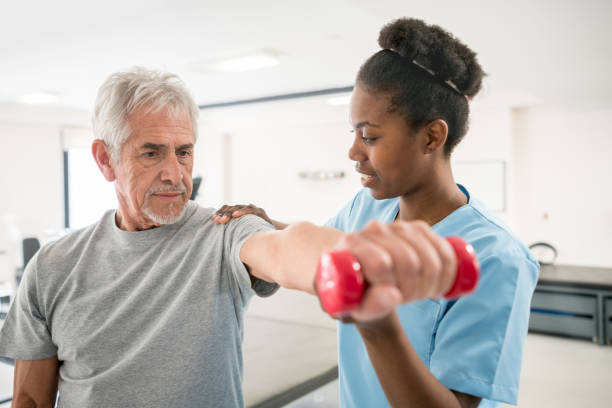
Expert Advice: Navigating Shoulder Impingement Like a Pro
Shoulder impingement is like that annoying friend who shows up uninvited at the worst times.
But don't worry! We've got some tips straight from the experts that'll help you show shoulder impingement the door.
"Hold It Right There!" Says Every Physical Therapist
First things first: when it comes to shoulder exercises, it's all about the pose. Imagine you're a superhero, holding an invisible shield.
You'll want to:
- Strike a Pose for 5 Seconds: Hold your arm in a position that feels like a stretch but doesn't hurt. It's like playing freeze tag with yourself.
- And... Relax: After those epic 5 seconds, let your arm chill out. It deserves a little break!
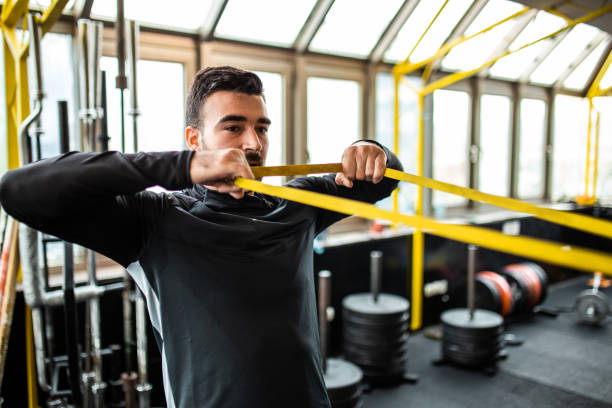
Move It or Lose It
Moving your shoulder is key. Think of it as taking your shoulder on a mini adventure:
- Swing It Side to Side: Gently, though! No wild dance moves.
- Be a Mirror: If your right shoulder is the troublemaker, then do the movements with your left, as if it's its reflection. This helps keep things balanced.
The 90-Degree Magic
Here's a fun fact: bending your elbow at a 90-degree angle is kind of magical for shoulder impingement. It's the sweet spot for many exercises.
- Top Arm Triumph: Raise your top arm (the superhero one) in front of your body but keep that elbow happy at 90 degrees. It's like you're arm wrestling an invisible opponent.
The Resistance Band Bandwagon
Hop on the resistance band bandwagon! These bands are not just colorful stretchy things; they're your shoulder's new best friend.
- Arm Out, Band Tight: Tie one end of your band to something sturdy and pull the other end with your arm out to the side. It's like you're a rock star guitarist strumming the world's longest guitar string.

Pain, Pain, Go Away
Sometimes, shoulder impingement can be a real pain in the... well, shoulder. Experts say a little help from NSAIDs (those are pain-relief medicines) can be a game-changer. But remember, they're like candy: good in moderation and under adult supervision (aka your doctor).
Weighty Matters
As you get stronger, you might think, "Let's add all the weights!" Hold your horses, champ. Increasing the weight slowly is key. It's like leveling up in a video game; you don't jump from level 1 to level 100 in a day.
Feel the Stretch
Ever tried giving yourself a hug? That's the vibe we're going for.
- Cross-Body High Five: Place one arm across your body, aiming for a pat on the back. It's like you're saying, "Good job, me!"
- Door Frame Lean: Lean into a door frame with your forearm up, and gently push forward until you feel a stretch. It's as if the door frame is your dance partner, leading you into a slow tango.

Listen to Your Body
The most important thing? Listen to your body. It's smarter than you think and will tell you when something's not right. If it says, "This hurts," it's time to stop and rethink your strategy.
Final Superhero Tips
Remember, dealing with shoulder impingement is a journey. With these expert tips, you're well on your way to being the hero of your own shoulder saga. Keep moving, keep stretching, and most importantly, keep smiling. Your shoulder will thank you!
For More Training Advice + Diet and Lifestyle visit us Combat Creatine
PS: Make sure you check out the rest of our Training Guides:
Creatine
Creatine Supplements Ultimate Guide
Creatine Supplementation Side Effects
Best Creatine Monohydrate Gummies Review: Top 10 Best Creatine Gummies
Triceps
12 Best Long Head Tricep Exercises + Tricep Workout Ideas
Top 17 Tricep Extension Exercises | Triceps Extension Variations Guide
Perfecting the Triceps Pushdown: Tricep Pushdown for Upper Body Strength
10 Best Medial Head Tricep Exercises -Combat Creatine10 Best Lateral Head Tricep ExercisesThe Best Triceps Stretches to Loosen and Improve Flexibility
Understanding Triceps Tendonitis: Causes, Diagnosis, and Treatment for Elbow Pain
Tricep Dips Exercise Guide: Master The Triceps Dip
30 Best Tricep Exercises | Review The Best Triceps Exercises
Are Triceps Push or Pull? Push-Pull Workout
Biceps
12 Best Bicep Tendonitis Exercises | Biceps Tendon Treatment
The 10 Best Kettlebell Bicep Exercises for Bigger, Stronger Arms
The 14 Best Resistance Band Bicep Exercises | Top Biceps Resistance Band Exercises
The 14 Best Short Head Biceps Exercises | Short Head Bicep Exercise Workout
17 Best Long Head Bicep Exercises | Top Biceps Exercise
The 20 Best Bicep Exercises | Best Biceps Exercise & Bicep Workout
Get Stronger Biceps with a Bicep Curl Machine
Chest
13 Cable Chest Exercises to Build Bigger Pecs
The Spoto Press: How This Unique Bench Press Variation Can Boost Your Bench
The 10 Best Chest Exercises for Building Muscle
10 Best Dumbbell Chest Exercises for Building Your Pecs
The 5 Best Chest Exercise Machines for Maximum Growth in 2024
5 Best Compound Chest Exercises for Building a Bigger Chest
16 Best Kettlebell Chest Exercises: Pump Up Your Pecs
5 Best Chest Workout Machines for Maximum Muscle Growth
6 TRX Chest Exercises for a Bigger Chest - Best TRX Workout!
14 Common Chest Expander Exercises
Back
10 Best Cable Back Workout Exercises
10 Best Kettlebell Back Exercises & Back Workout
5 Best Calisthenics Back Exercises + Calisthenics Back Workout
5 Best Lower Back Exercises + Best Back Exercises Machines
Top 10 TRX Exercises To Build A Stronger Back
10 Best Resistance Band Back Exercises + Back Workout
11 Best Landmine Exercises For Back & Upper Body
15 Best Smith Machine Back Exercises
Top 3 Back Exercises For A Stronger Back: Build Size And Strength
The Complete Helms Row Guide | Form, Muscles Worked, and Benefits
How to Do the Lat Spread Pose Like a Pro Bodybuilder
Shoulders
The 10 Best Cable Shoulder Workouts & Cable Shoulder Exercises
Shoulder Impingement Exercises For Shoulder Impingement Syndrome
8 Best Shoulder Bursitis Exercises
16 Best Cable Shoulder Exercises To Build Muscle & Shape Delts
10 Best Shoulder Dislocation Rehab Exercises
Shoulder Calisthenics Workout | Bodyweight Shoulder Workout
10 Best trx shoulder exercises | TRX Suspension Training
5 Frozen Shoulder Exercises For Pain Relief
Around the World Shoulder Exercises + Workout
8 Best Compound Shoulder Exercises
Supraspinatus Stretch: Your Supraspinatus Muscle & Rotator Cuff
Legs
9 Compound Leg Exercises | Best Compound Exercises For Lower Body
12 Best Kettlebell Leg Exercises | Leg Workout
Best 18 Calisthenics Leg Exercises | Calisthenics Leg Workout
Best 10 TRX Leg Exercises For Lower Body | TRX Leg Workout
10 Single Leg Exercises to Build Explosive Leg Strength
8 Best Hack Squat Alternatives That Target Your Quads
Easy Wall Exercises For Legs | Wall Workout
8 Best Landmine Exercises | Landmine Leg & Lower Body Workout
The Best Leg Strengthening Exercises for Seniors
Leg Press Machine Exercise | Ultimate Leg Press Workout Guide
Glutes
7 Best Lower Glute Exercises for Building the Perfect Underbutt
The 8 Best Gym Machines For Glutes | Best Glute Machine Review
8 Best Dumbbell Glute Exercises & Glute Workout
The 11 Best Cable Glute Exercises: Cable Exercises To Build Your Booty
10 Best Compound Glute Exercises | Compound Exercises
7 Best Kettlebell Glute Workouts | Kettlebell Exercises For Glutes
9 Best Unilateral Glute Activation Exercises | Lower Body Unilateral Exercises
The Ultimate 12 Week Glute Building Workout Plan PDF
Nutrition
The Ultimate Guide to High Protein Meal Prep
The Menopause Diet: 5-Day Plan to Lose Weight
The Struggle is Real: Crafting the Perfect Cutting Diet Without Losing Your Mind
TikTok Viral Valencia Diet Plan: Fad Diet or Nutritional Benefits?
Bruce Lee Diet & Body Fat: Unmasking the Legendary Physique
Fitness
The Ultimate 20-Minute Beginner Workout At Home Without Equipment
8 Best Kettlebell Lunge Variations for Strength, Hypertrophy and Cardio
How to Get Jacked: The Complete Guide to Building an Incredible Physique
How to Choose the Best Kettlebell Weight to Start With
Guide To Workouts For Beginners | Beginner Workout ExercisesPlank Every Day for 60 seconds | Plank Exercise Variations
Lionel Messi Shows Off Shredded Ab Workout
Sam Sulek Workout And Diet | Fitness Biography
Animalhouse Fitness: Lift Dumbbells with MonkeyFeet for Stronger Hamstrings and Hip Flexors at Home
Total Body Enhancement at Planet Fitness. How it works
Split Stance Trap Bar Deadlift Exercise: Variation That Builds Muscle
How Long Should You Wait to Exercise After Tooth Extraction?
Lifestyle
The Ultimate Guide to Ice Bath and Cold Plunge Temperatures & Time
The Ultimate Fitness Guide for Busy Dads
12 Clever Ways to Hide a Treadmill In A Room
Does Planet Fitness Have Scales?
Does Planet Fitness Have a Sauna or Steam Room or Hot Tub?
The Complete Guide to Putting a Squat Rack in an Apartment
How Much Does a Personal Trainer Cost in 2024?
Yogi Tea Kava Stress Relief Review: Herbal Tea Bags Breakdown
The Best Sleeping Positions for Peripheral Artery Disease
Best Sleeping Position For IT Band Pain
10 Types of Barbells | Different Types of Barbells To Lift In The Gym
Supplements
Joe Rogan's Supplement List: The Complete Guide to What He Takes and Recommends
The Best Prostate Supplement for Men in 2024
Is Honey and Salt Pre-Workout Good? Benefits of Honey and Pink Himalayan Salt
Dr. Gundry MD Reviews: Do These Supplements Really Work in 2023?
The Beginner's Guide to Dietary Supplements + Top 10 Supplements
Does Pre-Workout Break a Fast? Pre Workout Guide While Fasting
Peptide Therapy: CJC 1295 Ipamorelin For Growth Hormone Levels
